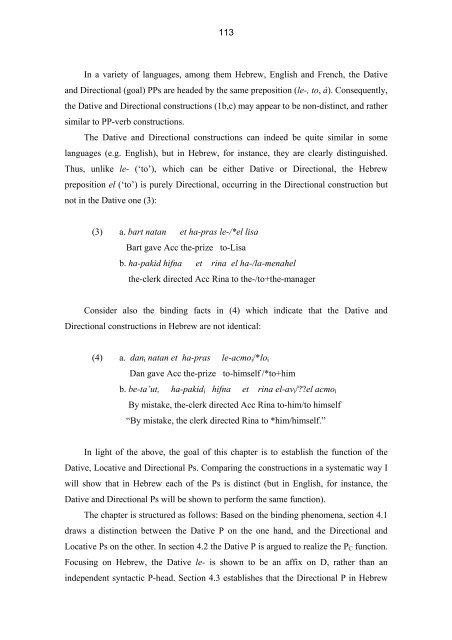The Category P Features, Projections, Interpretation
The Category P Features, Projections, Interpretation
The Category P Features, Projections, Interpretation
Create successful ePaper yourself
Turn your PDF publications into a flip-book with our unique Google optimized e-Paper software.
113<br />
In a variety of languages, among them Hebrew, English and French, the Dative<br />
and Directional (goal) PPs are headed by the same preposition (le-, to, à). Consequently,<br />
the Dative and Directional constructions (1b,c) may appear to be non-distinct, and rather<br />
similar to PP-verb constructions.<br />
<strong>The</strong> Dative and Directional constructions can indeed be quite similar in some<br />
languages (e.g. English), but in Hebrew, for instance, they are clearly distinguished.<br />
Thus, unlike le- (‘to’), which can be either Dative or Directional, the Hebrew<br />
preposition el (‘to’) is purely Directional, occurring in the Directional construction but<br />
not in the Dative one (3):<br />
(3) a. bart natan et ha-pras le-/*el lisa<br />
Bart gave Acc the-prize to-Lisa<br />
b. ha-pakid hifna et rina el ha-/la-menahel<br />
the-clerk directed Acc Rina to the-/to+the-manager<br />
Consider also the binding facts in (4) which indicate that the Dative and<br />
Directional constructions in Hebrew are not identical:<br />
(4) a. dan i natan et ha-pras le-acmo i /*lo i<br />
Dan gave Acc the-prize to-himself /*to+him<br />
b. be-ta’ut, ha-pakid i hifna et rina el-av i /??el acmo i<br />
By mistake, the-clerk directed Acc Rina to-him/to himself<br />
“By mistake, the clerk directed Rina to *him/himself.”<br />
In light of the above, the goal of this chapter is to establish the function of the<br />
Dative, Locative and Directional Ps. Comparing the constructions in a systematic way I<br />
will show that in Hebrew each of the Ps is distinct (but in English, for instance, the<br />
Dative and Directional Ps will be shown to perform the same function).<br />
<strong>The</strong> chapter is structured as follows: Based on the binding phenomena, section 4.1<br />
draws a distinction between the Dative P on the one hand, and the Directional and<br />
Locative Ps on the other. In section 4.2 the Dative P is argued to realize the P C function.<br />
Focusing on Hebrew, the Dative le- is shown to be an affix on D, rather than an<br />
independent syntactic P-head. Section 4.3 establishes that the Directional P in Hebrew
















